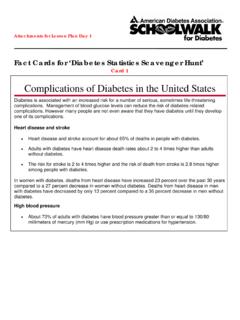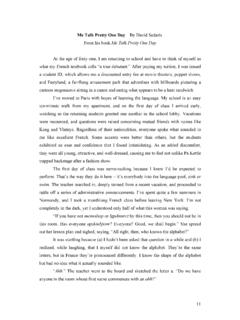Transcription of Diabetes Statistics Scavenger Hunt
1 Diabetes Statistics Scavenger hunt Day 1. Objective: Have students (in pairs) complete the following statements from information cards spread around the room under each category (Fact Cards Attached): Complications of Diabetes in the Total Prevalence of Diabetes and Pre- Diabetes Direct and Indirect Costs of Diabetes in the The Dangerous Toll of Diabetes 1. Diabetes is a disease that causes _____ to rise to dangerous levels because of a lack of or inability of the body to use _____. 2. 65% of people with Diabetes die from _____ and _____. 3. People with Diabetes have a _____times higher chance of dying from a stroke than people without Diabetes . 4. Over the past 30 years the death rate of women with Diabetes has increased by ____% while the death rate of women without Diabetes has decreased by _____%, 5.
2 In 2007, the total cost of Diabetes was an estimated _____ billion dollars. 6. Indirect costs of Diabetes include things like: increased _____, reduced _____, disease-related _____ disability, and loss of productive capacity due to early _____. 7. In 2007, one out of every _____ health care dollars was spent caring for someone with Diabetes . 8. In 2007, medical expenditures for someone with Diabetes was_____ times higher than for someone without Diabetes . 9. In 2007, Diabetes related hospitalizations totaled _____ days. 10. An estimated _____ million children and adults in the US with Diabetes , or _____% of the population. 11. Of that number, _____ have been diagnosed. Unfortunately, another _____ are not aware that they have the disease. 1-888- Diabetes (342-2283). Diabetes Statistics Scavenger hunt cont.
3 12. If the present trend continues, one in _____ Americans, and one in _____ minorities, born in 2000 will develop Diabetes in their lifetime. 13. Every day, approximately _____ people are diagnosed with Diabetes . 14. Diabetes is the _____th deadliest disease in the US. 15. What is type 1 Diabetes . _____. _____. _____. 16. What is type 2 _____. _____. _____. 17. What is the difference between type 1 and type 2 Diabetes ? _____. _____. 18. What is the difference in treating type 1 and type 2. Diabetes ?_____. _____ _____. 19. How many adolescents aged 12-19 have pre- Diabetes ? _____. 20. What are some warning signs of type 1 and types 2 Diabetes ? Type 1 Type 2. _____ _____. _____ _____. _____ _____. _____ _____. _____ _____. _____ _____. 1-888- Diabetes (342-2283). 21. What percentage of Non-Hispanic whites have Diabetes ?
4 _____%. 22. What percentage of Non-Hispanic blacks have Diabetes ? _____%. 23. Approximately what percentage of Hispanic/Latino American have Diabetes ? _____%. 24. Approximately what percentage of American Indians/Alaskan natives have Diabetes ? _____%. 25. In 2004,how many people had their lower leg amputated because of Diabetes ? _____. 26. How many new cases of blindness are the result of Diabetes each year? _____ to _____. 27. Who is at a greater risk for type 2 Diabetes ? Types of people: _____ _____. _____ _____. _____ _____. _____ _____. 28. Why is it important to know about Diabetes ? _____. _____. _____. 1-888- Diabetes (342-2283). chalk Talk Day 2 Pre-reading/Writing strategy Objective: Begin with a chalk Talk activity. The irony of chalk Talk is that it requires neither chalk , nor talk.
5 It requires a large sheet(s) of butcher paper hung on the wall with markers for every student to write on the paper. At the top of the butcher paper write the following question: Do you think that schools have the right to regulate what students eat at school (breakfast, lunch and drinks)? Have students respond to the question, to each others comments, or just thoughts they may have about the topic for 10 minutes without any talk. Tell them to sign their initials under each of their comments. They may continue to comment as often as they like. This helps the teacher see that everyone is participating. Then the teacher or selected group leader can group ideas by similarities, by circling ideas that repeat thematically. Then, the students will summarize the comments into the two groups: YES - schools should regulate what students eat NO - schools should not regulate what students eat 1-888- Diabetes (342-2283).
6 Reading, Chunking, and Discussing Day 3. Objective: Have the students read the attached article silently and add post-it arrows (or use colored highlighters) where appropriate. Article is titled, Fat & Politics: Suing Fast Food Corporations . Red Arrow: This is something I hadn't thought about before. Green Arrow: This is a good reason for the government to back off and let people have freedom. Blue Arrow: This is a good reason for the government to impose a fat tax . Yellow Arrow: I disagree with this statement. Purple Arrow: I am going to remember this and tell someone. In groups of four, have a student start with the Red Arrow and describe where they put it and why, then make the rounds . Have each student tell where they put their red arrow and why and so on until all arrows have been discussed.
7 1-888- Diabetes (342-2283). Meet the Press Day 4. Objective: Keeping all that you have learned about Diabetes in mind, write a persuasive letter to your school paper (an editorial) about whether students should or should not have a say or input in the food services decisions in your school. Justify your position using information, data from the Statistics , and the previous article you read on Fat & Politics . 1-888- Diabetes (342-2283). Food Police: What will you choose? Day 5. Objective: Read the advertisement attached from a popular magazine, by the Consumer Freedom group. This ad describes one side of the debate about individual responsibility versus government regulation. Answer the following questions: 1. What side is this ad for? _____. 2. What context clues led you to that conclusion?
8 3. In the space below create an ad for the other side of the argument. 1-888- Diabetes (342-2283).







